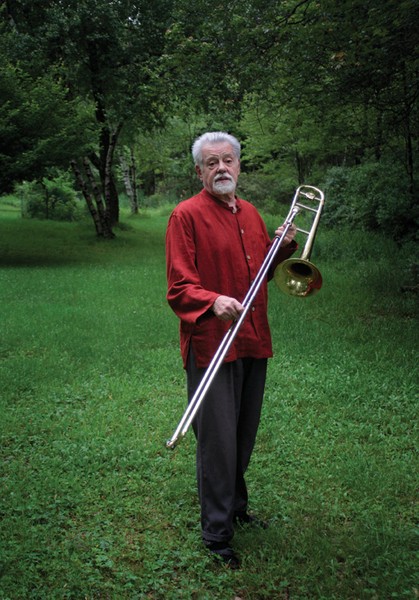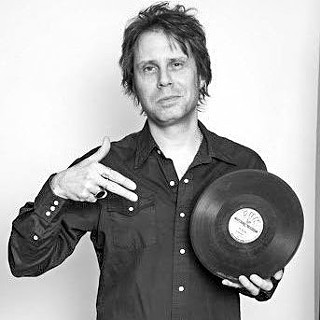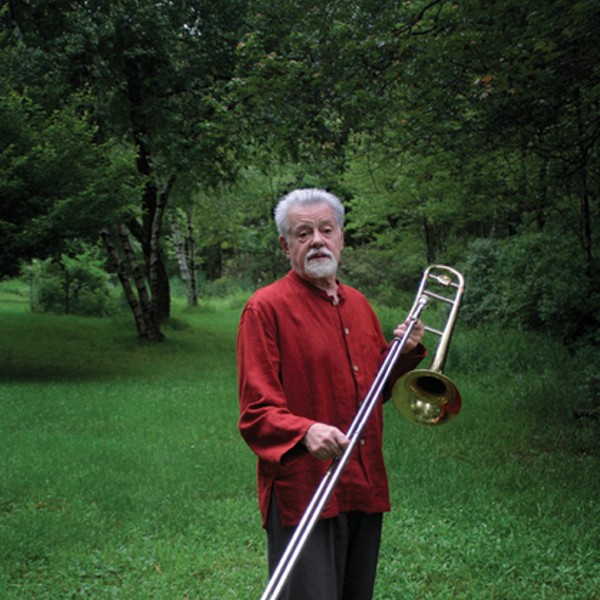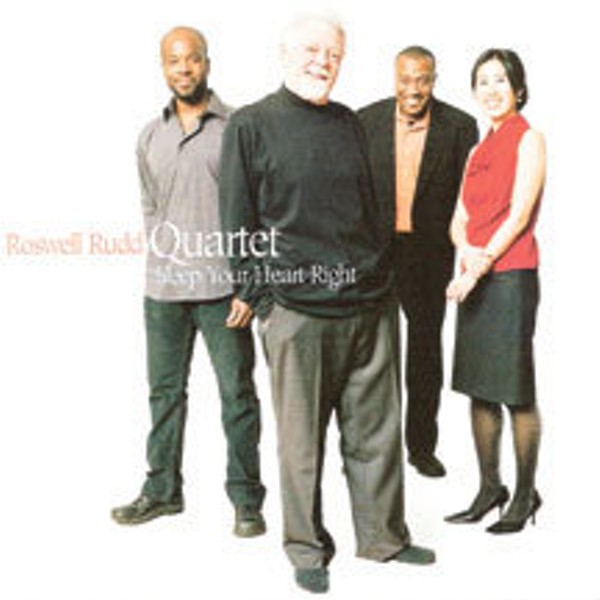Peaceful isn’t the word for the 21 acres that envelop the Kerhonkson house trombonist Roswell Rudd inhabits with Verna Gillis, his companion and manager. Thick with tall pines and hearty brush, the striking stillness of the property is troubled only by the occasional cheeping bird. It’s a meditator’s dream spot. But to Rudd, he and Gillis are surrounded not just by nature, but also by music.
“There’s some really great notation out there,” says the goateed, professorly composer as he glances toward his living room window. “I love to grab my horn and go out in the woods, play what I see and feel.”
Notation? Where? And how, exactly, does one “play” the natural environment?
“I have an expanded concept of what notation is,” explains Rudd. “I call it landscape notation; it’s about moving beyond the traditional system of just playing specks on a piece of paper. Music is naturally in the atmosphere all around you, all the time. It’s just a question of using your eyes, your ears, and your other senses to make the tune. Besides the sounds that you hear—the birds, the wind—there’re other dimensions to draw on: the colors, the shapes, the textures, the feelings you get. I approach the notes I find in nature the same way as the ones I see when I’m playing something off the page.”
It’s a curious concept, to be sure, but one that seems to be working perfectly when you get an earful of the man’s bold and forward-looking craft. At 74, Rudd is known as the father of free jazz trombone and a pivotal figure of the 1960s and ’70s avant-garde; he’s also an acclaimed cultural synthesist, having recorded and performed with leading indigenous folk musicians from around the world. But for all of his oddly metered, hard-blowing iconoclasm, Rudd began his musical journey in his hometown of Lakeville, Connecticut, on some very traditional ground: Dixieland.
“I took piano lessons when I was really young, but when I heard my dad’s Louis Armstrong 78s, I said, ‘This is what I wanna be doing!’” Rudd says. When he was 12, after he’d studied French horn for a few years, Rudd’s parents, both casual musicians, had an uncle buy the boy a pawnshop trombone. By the time he was a student at Yale in the mid 1950s he was playing tailgate in Eli’s Chosen Six, a Dixieland revival band. “That was something, playing rags and stomps for drunk college kids,” Rudd recalls with a laugh. “But we’d improvise as much as we could, throw in five or six extra choruses on ‘Royal Garden Blues,’ let everyone take a turn. It was pretty loose. You know, party music.”
Although his chosen instrument’s inherent lack of flexibility didn’t lend itself well to bebop—outside of the great J. J. Johnson, Frank Rosolino, and Jimmy Cleveland, bop trombonists were few—Rudd nevertheless graduated to the more demanding style, studying with trail-blazing pianist Herbie Nichols for two years. “One thing I learned from Herbie and the other bop pianists, like Monk and Bud Powell, is that you can transpose their tunes from the keyboard for a whole orchestra,” says Rudd. “Each finger can represent a potential instrument.” It was this very concept that lead to the formation of his next band, a Thelonious Monk repertory ensemble, retroactively dubbed the School Days Quartet, which also featured influential soprano saxophonist Steve Lacy, whom Rudd had met in his Dixieland days. But it wouldn’t be long before he’d take the plunge into complete musical freedom.
In New York full time by the early 1960s, Rudd sought out pianist and free jazz pioneer Cecil Taylor for lessons on theory and briefly played with radical saxophonist Archie Shepp in a band led by trumpeter Bill Dixon. In 1964 he contributed to the soundtrack of the underground jazz film New York Eye and Ear Control and with saxophonist John Tchicai founded the New York Art Quartet; the short-lived but hugely influential outfit recorded for the famed ESP-Disk imprint and performed at that year’s galvanizing October Revolution in Jazz festival at the Cellar Café. “There was a new spirit in the musical atmosphere, for sure,” remembers Rudd. “What [Rudd and his cohorts] were doing was maybe too edgy for a lot of people, but to me it was just updated Dixieland. Like the original New Orleans jazz, it was collective improvisation, but it was informed by bebop and everything else that had come in between. And it was great to find comrades like Archie [Shepp], Carla Bley, and other folks to work with.”

















